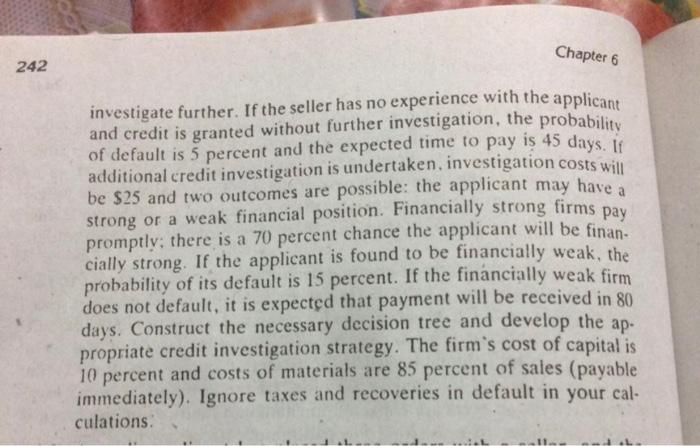Problems 6-1. A firm is trying to formulate a credit investigation policy for order amounts of $500. When an order is received, the firm can accept the order, reject the order, or investigate further. If the order is accepted without further investigation, the probability of default is 5 percent and it is expected that payment will be received in 45 days (terms of sale are 30 days). If the firm clects to investigate, the costs of this investigation are $5, and three results are possible: the applicant may have paid promptly in the past, the applicant may have defaulted in the past, or the firm may have no experience with the applicant. The probabilities of these outcomes are 0.75, 0.05, and 0.20. If the seller has experience with the applicant, it is assumed that future credit granting will have the same result as past credit granting. At this stage, the seller may grant credit to the applicant without further investigation, reject the applicant, or Chapter 6 242 a investigate further. If the seller has no experience with the applicant and credit is granted without further investigation, the probability of default is 5 percent and the expected time to pay is 45 days. If additional credit investigation is undertaken investigation costs will be $25 and two outcomes are possible: the applicant may have strong or a weak financial position. Financially strong firms pay promptly; there is a 70 percent chance the applicant will be finan. cially strong. If the applicant is found to be financially weak, the probability of its default is 15 percent. If the financially weak firm does not default, it is expected that payment will be received in 80 days. Construct the necessary decision tree and develop the ap- propriate credit investigation strategy. The firm's cost of capital is 10 percent and costs of materials are 85 percent of sales (payable immediately). Ignore taxes and recoveries in default in your cal- culations Problems 6-1. A firm is trying to formulate a credit investigation policy for order amounts of $500. When an order is received, the firm can accept the order, reject the order, or investigate further. If the order is accepted without further investigation, the probability of default is 5 percent and it is expected that payment will be received in 45 days (terms of sale are 30 days). If the firm clects to investigate, the costs of this investigation are $5, and three results are possible: the applicant may have paid promptly in the past, the applicant may have defaulted in the past, or the firm may have no experience with the applicant. The probabilities of these outcomes are 0.75, 0.05, and 0.20. If the seller has experience with the applicant, it is assumed that future credit granting will have the same result as past credit granting. At this stage, the seller may grant credit to the applicant without further investigation, reject the applicant, or Chapter 6 242 a investigate further. If the seller has no experience with the applicant and credit is granted without further investigation, the probability of default is 5 percent and the expected time to pay is 45 days. If additional credit investigation is undertaken investigation costs will be $25 and two outcomes are possible: the applicant may have strong or a weak financial position. Financially strong firms pay promptly; there is a 70 percent chance the applicant will be finan. cially strong. If the applicant is found to be financially weak, the probability of its default is 15 percent. If the financially weak firm does not default, it is expected that payment will be received in 80 days. Construct the necessary decision tree and develop the ap- propriate credit investigation strategy. The firm's cost of capital is 10 percent and costs of materials are 85 percent of sales (payable immediately). Ignore taxes and recoveries in default in your cal- culations








